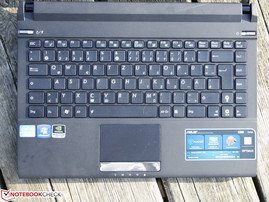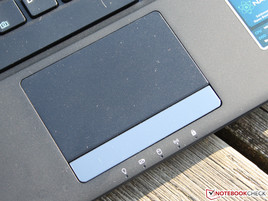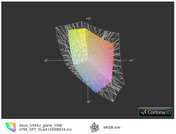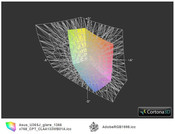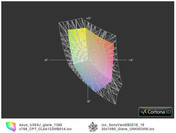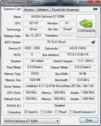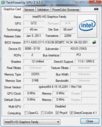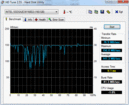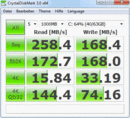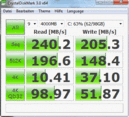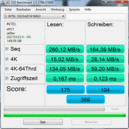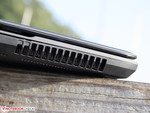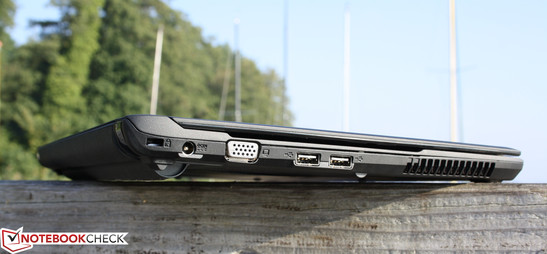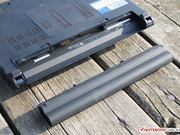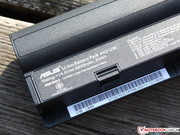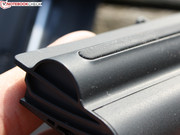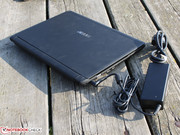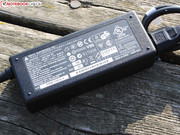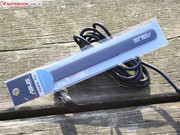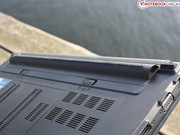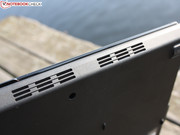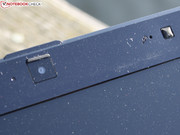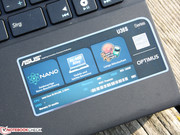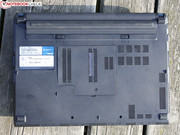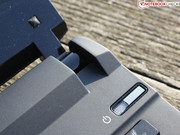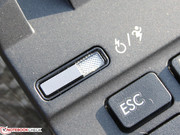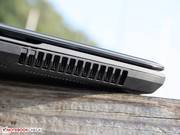Review Asus U36SD-RX114V (SSD) Subnotebook

At the beginning of 2011, the Asus U36JC-RX081V (silver) went through our tests and finished with a "GOOD" of 86%. Now its successor stands in our editorial office, namely the US36SD-RX114V in black. The 13.3 inch device doesn't eliminate all of its predecessor's shortcomings, but it once again shows us the prior strengths and, owing to Intel's SSD Series 320 (160 GB), the performance has increased considerably.
The 2010 Intel Core configuration (i5-480) has been exchanged for an i5-2410M from the succeeding Sandy Bridge generation. In the course of technical progression, the less attractive Geforce 310M has been jettisoned and replaced by a DirectX 11 entry level GPU, the GeForce GT 520M. Combined with four gigabyte of working memory, we face a strong, 1.67 kilogram heavy subnotebook for 1100€.
Is the U36SD-RX114V better than the previous U36JC-RX081V and can it achieve a "Very Good" this time around? We have to answer this with a "no" when looking at the test certificate. Find out in the following review why the rating is equivalent to its predecessor's despite higher performance.
Case
Users who scour the laptop jungle for a robust, matt, work-suitable yet elegant case sometimes find themselves venturing on a difficult task. Lid, case, TFT bezel or key gaps are either coated in high-gloss or the laptop is such an unattractive chunk of plastic that the style conscious user prefers hiding the laptop in the bag when friends approach.
Embarrassments or compulsions of this kind need not be suffered with the U36SD. Although "only" Asus and not Apple is printed on the 13.3 inch device's box, envious glances are certain. The angular, strict design in matt black can be held without slipping out of the hands. Neither the lid nor the bottom warps during handling. Particularly the thin lid has a remarkable torsional stiffness.
Asus achieves this by using an aluminum magnesium alloy for the lid's back and case's top. This combination is light on the one hand, and rigid on the other. The surfaces have been given a velvety black finish that Asus calls nano-coating. No matter where we pull or press the case, the U36SD remains unaffected from normal forces.
The lid is kept closed rather tightly. It has a clear stop at a wide 145 degrees and the TFT doesn't tend to teeter much. The key surface doesn't yield even the slightest bit while typing on it and the same is true for the wrist rest. Asus has done a good job with the rigidity although the battery is removable. However, it juts out and lifts the device a bit from the table and can be pushed out of the back after unfastening two release latches.
The SSD is built in as a standard 2.5 inch sized SATA drive. However, it remains hidden because replacing it is only possible by removing the entire base plate. Merely two RAM slots (1x4096 installed, upgrade option) are found under a cover.
Connectivity
Connectivity is not the U36SD's strength. Insofar, nothing's changed in comparison to the prior U36JC. Nevertheless, we can say that the ports, including HDMI, VGA, Ethernet and (1) USB 3.0 are apt for a subnotebook. The USB 3.0 port can charge 5 volt devices, such as smartphones and some tablet PCs, when the subnotebook is turned off (sleep & charge). The only difference to the predecessor is found in Bluetooth. Version 3.0 is now installed.
Communication
WLAN standard draft-n (Atheros AR9002WB-1NG) is just as much standard as the built-in Bluetooth module (3.0+HS) and the Gigabit Ethernet (Atheros AR8151). Thus, users are up to date. Regrettably, an integrated 3G modem for mobile Internet access isn't installed – that would have been a highlight. Unfortunately, Asus doesn't have a model configured with HSDPA/LTE modem in its range.
Supplies
There are no recovery DVDs for Windows 7 Home Premium (64bit) included in the box. The user has to create his data carriers with AI Recovery Burner. LifeFrame, the Asus tool for taking pictures or videos with the webcam, can only make pictures in 640x480 pixels. The results are feasible in daylight, but image noise and blurring are an issue in poor light conditions.
The scope of tools is abundant: Power2Go (burner) is the only commercial software (full version). Besides that, there is a range of Asus tools: Sonic Focus (sound enhancement), AI Recovery Burner, Secure Delete (irrevocable delete), USB Charger (on/off charge function, charge state), Fast Boot (applications in system start), Live Update (driver update), Scene Switch (desktop motives) or Power4Gear Hybrid (energy profile).
Warranty
The U36SD comes with a 24 month warranty including pick-up & return service. The warranty extension of up to three years costs about 80€. It has to be activated within 90 days after purchase.
Input Devices
Keyboard
The stand-alone keys provide a good feedback. They have a large gap to their neighbor and the pressure point as well as key drop is very clear, respectively distinctive. The keystroke is firm but not hard. The keyboard's surface doesn't yield. Professional laptop typists will criticize the orientation on the keys. The fingers lack a bit of guidance due to the absence of a conic curvature (inner curve). The arrow keys aren't separated from the other keys, but at least they have a size (15x15mm) that should prevent wrong entries to the largest part.
Touchpad
The Synaptics touchpad works accurately and allows the finger to glide over the surface, with a diagonal of 9.4 mm, with clear but not too high friction. The pad can be disabled via the FN key. The multi-touch characteristics detect the use of two fingers. This allows finger gestures (zoom, scroll, browse). The traditional, single-finger scroll bars exist (can be disabled), but aren't visibly marked. The silver keys (right + left) unfortunately have a very short key drop and emits a loud and muffled click noise with its clear pressure point.
Display
The glossy surface of the 13.3 inch screen (16:9) doesn't please the testers and the one or other potential buyer will likely also find it disagreeable. Asus replicates the contrast and dull glare-type display of the preceding U36JC. Although the screen models are different, the brightness and contrast measurements are absolutely identical (here: CPT CLAA133WB01A, U36JC: COR17D8).
If it's to be a glare-type, then at least with a broad color spectrum. But, Asus doesn't treat us to this. sRGB and Adobe RGB are clearly failed. The high black value of 1.44 also contributes to the pale colors and black with a gray cast. Devices like the Vaio EB3Z1E/B with a FHD screen (15.6 inch), which was available for 800€, proves that this isn't inevitable.
| |||||||||||||||||||||||||
Brightness Distribution: 80 %
Center on Battery: 224 cd/m²
Contrast: 149:1 (Black: 1.5 cd/m²)
39.6% AdobeRGB 1998 (Argyll 3D)
57.3% sRGB (Argyll 3D)
38.31% Display P3 (Argyll 3D)
A subnotebook that looks this good and has a battery life of over seven hours must of course be shown in the train, the library or the café. The user is faced with the reflective TFT surface and the low brightness of averagely 207 cd/m2, which fails in sunlight. In order to read the glare display adequately in the sun, the brightness should have a rate of at least 300 cd/m2.
Alike the brightness, the viewing angles don't meet the expectations. However, there are only a handful of premium subnotebooks with good because wide viewing angles. The picture already penalizes the slightest vertical deviation of angle (from 10 degrees) with fading colors up to ghosting. Script stays legible into wider angles. Viewing angles of up to 45 degrees are possible horizontally (lateral view). Massive inverting is seen beyond that.
Performance
The 2011 Intel Core i5-2410M (2x2.3 GHz) has a Turbo clock of up to 2.9 GHz. Consequently, the Sandy Bridge CPU resembles the i5-480M (Turbo: 2.93 GHz) in the U36JC (predecessor). Due to the slim case with low cooling performance, it is doubtful if the Intel cores can be overclocked beyond the specified maximum clock (short-term) via the "Dynamic Range @ Turbo Frequency Limits", or if they would even throttle the clock below the default rate (2.3 GHz) due to high temperatures.
The Nvidia Geforce GT 520M (1024 MB) can be disabled by Nvidia's Optimus in favor of a solely active HD Graphics 3000 (processor graphics). The RAM configuration is 4 GB, whereby the inserted 4096 MB module allows an easy upgrade to six or eight gigabytes.
What is the 2410M (2.3 GHz) capable of in comparison to the U36JC's configuration with a 2010 i5-480M (2.66 GHz)? The newer generation's clock is even a bit lower, but the Turbo clock is equal (2.9 GHz).
The 2410M achieves 4635 points in single core processing (Cinebench R10 single 64 bit). The higher clocked 480M's score of 3927 points is clearly defeated. The somewhat stronger, but very rare i5-2430M (2.4-2.3 GHz) only delivers a slight bit more speed with 4670 points. The virtually inexistent advantage could also be a reason why the 2430M actually isn't used. Unlike the i5-2520M that supplies 5015 points after all (Vostro 3550).
Multi threading with a high clock, measured here with Cinebench R10 Multi 64 bit, ensures a fast execution of simultaneous tasks. The 2410M reaches 9508 points in this test. The 480M from 2010 is clearly beaten: ~8557 points (average of all test devices). The high-end dual core 2520M (2.5 - 3.2 GHz) manages ~10546 points in this test.
All in all, the smallest i5 from the current Intel range manages very well. Above all, because the test results also don't show any losses in performance due to throttling. Just this was one fear in view of the thin case which only bids heatpipes and fans little room for waste heat. The CPU tests however supplied average to over-average rates in all areas for this CPU model. In comparison: The Aspire 4830TG with a 2410M, afflicted with CPU throttling, just managed 3609, respectively 7932 points in the above tests (Cinebench R10 single/multi core).
Secondly, the SSD comes into play and thrusts the U36SD to very good rates in terms of system performance. The older PCMark Vantage finishes with 9431 points. Notebooks only achieve about 5300 points with a built-in HD 3000 graphics and a 2410M (e. g. MSI CX640). Even 7736 points are possible when a fast 7200 rpm HDD is used (Vostro V131). Without that, but with a stronger GPU, an Aspire 5830TG manages 6632 points. Only other SSD based laptops can beat the U36SD, for example the XMG A501 (11848) or the Toshiba Satellite R850-127 (10378 points).
The new PCMark 7, which takes greater account of the GPU performance, reaches 2861 points. Consequently, a Packard Bell NX69, with the same CPU but stronger GT 540M, can't keep up: 1849 points. The decisive advantage for the U36SD is in the Storage Score of 4509 points. The NX69 (HDD) only reaches 1349 points. For instance, the Asus K53TA (HDD) achieves 1470 points and the LG A520 (HDD) manages 1509 points.
| PCMark Vantage Result | 9431 points | |
| PCMark 7 Score | 2861 points | |
Help | ||
The Nvidia GeForce GT 520M (1024 MB DDR3, core: 740 MHz), based on the GF 119 core, plays in the entry level class. It has a 64-bit video memory bus and right here is its performance bottleneck. Consequently, high details are only possible in low resolutions up to about 1024x768 pixels. The DirectX 11 GPU's performance is below that of a GT 540M (128 bit), a Radeon HD 6550 or HD 6650 (both 128 bit) in most benchmarks.
The synthetic benchmarks, such as Unigine Heaven 2.1 (8 fps), verify that the GT 520M has a performance marginally above the HD 6470M (-14%) and is almost on a par with a HD 3000 (+5%) or Nvidia's NVS 4200M (-1%). The sister model, GT 540M clearly has the lead with ~13 fps.
In return, 3DMark 11 (GPU performance: G501) prefers the HD 6470M (+8%). The popular GT 540M reaches a considerably higher score here: ~G900. The older 3DMark06 achieves a score of 4741 points in contrast to a HD 3000 with 4000 points (average of test devices). The GT 540M manages 8000 points on average!
The GT 520M seems only suitable for games to a very limited extent. In particular, the minor difference to a HD 3000 processor graphics brings up the question, at least for games, why two weak GPUs have been combined via Optimus here. Does the superior driver support from Nvidia advocate the use of a GT 520M in the U36SD?
| 3DMark 06 Standard Score | 4741 points | |
| 3DMark Vantage P Result | 2351 points | |
| 3DMark 11 Performance | 569 points | |
Help | ||
The rates measured by CrystalDiskMark 3.0 (read 258 MB/s, HDTune (read 141 MB/s) and AS SSD benchmark (read 260 MB/s) speak for the Intel SSD 320 Series (160 GB, model: MLC, SATA at 3GB/s port). Typically, the SSD's strength is in read/write of random blocks. This is even a special strength of the 320, as CDM and AS SSD confirm. The SSD of a Samsung Series 9 900X3A (mSATA at 3GB/s port) lagged behind in reading small blocks (CDM 4K: 10 versus 16 MB/s). AS SSD shows the reason: A shorter access rate (0164 vs. 0.301 milliseconds). The advantage is again relativized in write.
One thing is sure: Typical laptops with a 5200/7200 rpm HDDs lag far behind. Their typical throughputs are between 65 and 85 MB/s (read/write).
Gaming Verdict
The newest games shouldn't be added on the wish list by any means. They can only be played in low details and resolutions when DirectX 11 details are disabled. Older tracks, such as Half Life 2 - Lost Coast, World of Warcraft, Call of Duty 4 - Modern Warfare, Trackmania Nations Forever, Racedriver, GRID or Left4Dead, will however be playable in high and, if necessary, medium details as the spec sheet of the GT 520M shows.
The performance difference between the HD 3000 (IGP) and GT 520M varies in Deus EX (+12% @ low details), Dirt 3 (+26% @ medium details) and Battlefield: BC2 (+2% @ low details) and Mafia 2 (+74% @ low details). However, it is usually in favor of the GT 520M. So, it can't be said that casual gamers won't benefit from the GPU beside the HD 3000.
| low | med. | high | ultra | |
|---|---|---|---|---|
| Battlefield: Bad Company 2 (2010) | 34 | 25.7 | 18.3 | |
| Mafia 2 (2010) | 37.4 | 24 | 19 | |
| Dirt 3 (2011) | 67.7 | 29.5 | 18.6 | |
| Deus Ex Human Revolution (2011) | 60 | 22.1 |
Emissions
System Noise
The 13.3 inch device shows itself exemplary in system noise. The fan is inactive most of the time in idle and during low load and only turns up sporadically to 31.2 dB (A). The selected energy mode doesn't play a role here (Power4Gear: Quiet Office). When a GPU load is added, for example by a game or 3DMark06, we measure a maximum of 34.5 dB (A).
Users who like to demand the highest performance from their laptop will experience a noise level of up to 39 dB (A) (@ Cinebench R11.5). The U36SD gets really loud when the GPU and CPU are loaded to the maximum simultaneously. Now, a high pitched 44.3 dB (A) are audible. The latter scenario is our stress test which simulates the highest noise level - an unrealistic case in practical use.
Noise level
| Idle |
| 29.6 / 29.6 / 31.2 dB(A) |
| DVD |
| 34.5 / dB(A) |
| Load |
| 0 / 44.3 dB(A) |
 | ||
30 dB silent 40 dB(A) audible 50 dB(A) loud |
||
min: | ||
Temperature
The U36SD doesn't only prove to be a quiet companion. The top and large parts of the base plate stay lukewarm to warm in idle mode and during sporadic load (office scenario). Only the area in the power cord's/power button's vicinity come very close to the 40 degree mark during stress-free operation.
The temperatures increase up to 48 degrees Celsius selectively during load. This is clearly perceived as overheated. A minor CPU throttling can also be noticed in this scenario. Positive: The wrist rest and touchpad always stay noticeably below 35 degrees.
(Minor) throttling @ GPU load
The CPU clock throttles to 2.4 GHz (default clock: 2.3 GHz) in the Turbo range during a multi-hour stress test (Prime95 + Furmark). In CPU stress only, induced by Prime95, the clock is 2.7 GHz. Short: Since the frequency is always higher than the default clock, it can't be seen as real throttling. In opposition to the 13.3 inch Aspire TimelineX, we are looking at a slim notebook that doesn't seriously suffer under performance throttling, but simply can't completely exhaust the Turbo bandwidth in the stress test. This is only noticed during simultaneous GPU load in the U36SD.
(±) The maximum temperature on the upper side is 43.1 °C / 110 F, compared to the average of 35.9 °C / 97 F, ranging from 21.4 to 59 °C for the class Subnotebook.
(-) The bottom heats up to a maximum of 48.5 °C / 119 F, compared to the average of 39.3 °C / 103 F
(+) In idle usage, the average temperature for the upper side is 25.9 °C / 79 F, compared to the device average of 30.8 °C / 87 F.
(+) The palmrests and touchpad are reaching skin temperature as a maximum (35 °C / 95 F) and are therefore not hot.
(-) The average temperature of the palmrest area of similar devices was 28.2 °C / 82.8 F (-6.8 °C / -12.2 F).
Speakers
Two stereo speakers are located on the laptop's narrow front part. The sound emphasizes the high ranges and neglects the mid and deep ranges. Basses are non-existent. The volume can only be turned up to full with clear distortions, which even worsens the sound. Music lovers should connect headphones or external speakers via the analog headphone out.
Clearness of speech, surround and bass can be modified with the Asus Sonic Focus tool. The result is even appealing in the case of speech intelligibility because at least the vocals are emitted clearly from the overall poor sound.
Battery Life
The long idle runtime (lowest brightness, energy savings mode) lets us presume low power consumption. The measurements don't confirm this, at least not the high savings that would be expected. First, the idle power consumption: Idle ranges from 10.5 to 14.5 watts, depending on the power mode. These figures represent the minimum and maximum power requirement in idle (without battery charging). A Packard Bell NX69 (14 inch), with the same CPU but stronger GT 540M, only draws 7.6 to 12.5 watts out of the socket (60 Wh battery, almost 12h idle!).
The U36SD then gets really hungry in the stress test (Prime95, Furmark) and consumes 72 watts. The formerly mentioned NX69 is satisfied with 58 watts but only because the CPU throttles the clock significantly. Our test device doesn't do this, so the "high" load power consumption can be seen as a confirmation of the stable cooling system. The quite big 75 watt power adapter (304 grams) is bulky, but also necessary for the demand and thus just right.
| Off / Standby | |
| Idle | |
| Load |
|
Key:
min: | |
The battery runtimes turn out to be very good, but can't surpass the excellent specifications of the prior U36JC (HDD, i5-480M). The U36SD lasts 9:10 hours in idle (U36JC: 10:09 hours). The practically more relevant WLAN test closes after 7:45 hours (U36JC: 8:07 hours). An 80 watt battery takes care of the very good runtime. It can be removed and juts out a bit at the bottom.
The battery life isn't bombastic though, if we compare it with the Packard Bell NX69 with its 11:40 hours of standby and 6:39 hours of idling. This 14 inch device "only" has a 60 Wh battery and a stronger GT 540M graphics (can be disabled via Optimus).
Verdict
Asus achieves many good rates and a few are even better than the preceeding U36JC's. But unfortunately, the biggest shortcoming, the reflective and too dark for use in the sun screen is exactly the same. This doesn't make the 13.3 inch device's biggest advantage, the long battery life of nearly eight hours, useless but it reduces the fun of working in the sun considerably.
The Core i5 2410M, 2.3 GHz, used in many cases isn't a performance star, but together with the Intel Series 320 SSD (160 GB), the dual core aims at maximum power in system performance. All hard disk laptops are clearly defeated in read and write. Praiseworthy: CPU throttling is virtually non-existent. Acer's TimelineX ultrabooks can especially take a page out of its book.
The U36SD's low noise in office mode or simple applications is exemplary. Even games don't perturb the 13.3 inch device, which isn't very surprising in view of the weak graphics performance.
A good job has been done with the keyboard in terms of layout and feedback. Asus has opted for a torsional stiff and hard material with the aluminum case, which is in line with the angular and matt looks. That turns the U36SD into a compact, high-quality and slim subnotebook that users will like to take out of the case to show.
Users who choose their next subnotebook in view of soft criteria, such as workmanship and robustness, will make a good choice with the U36SD. The performance is very good thanks to the SSD. However, if the latest games are to be played, a Geforce GT 540M should be preferred. Acer has the Aspire TimelineX 3830TG with a Core i7 and a 128 GB SSD for the same price of 1100€ in its range (inferior case stability, throttling). The Acer TravelMate TimelineX 8473TG with a 120 GB SSD and also a GT 540M is available for less (stable but bulkier, no throttling).
To make the dream of a high-quality SSD subnotebook at a low price come true, the Samsung QX412 for 900€ (version QX412-S04DE with a 128 GB SSD) might be an alternative. The 14 inch device is also equipped with a GT 520M. If the dedicated graphics is seen as useless ballast, HP's ProBook 5330m (non-glare, 13.3 inch) or Dell's Vostro V131 (800-950€) might be considered. Should that be too expensive, the SSD version of Lenovo's ThinkPad Edge E325 might be appealing (starts at 439€).









